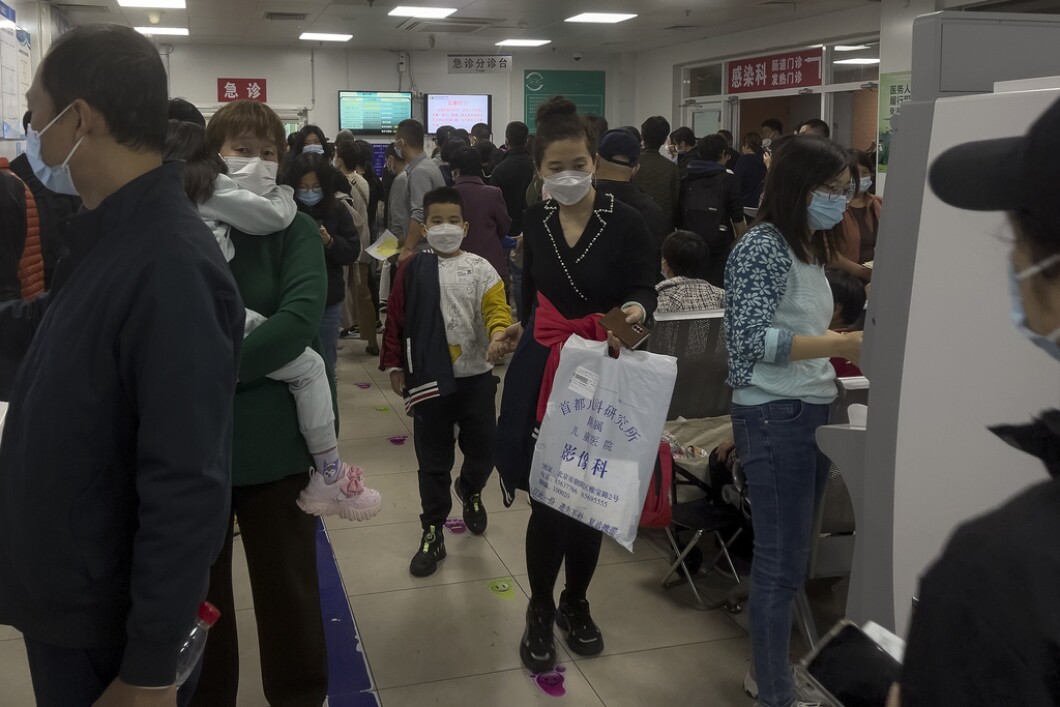
A wave of childhood respiratory illnesses in China is not only overwhelming doctors and hospitals, but it is also prompting questions about the spike itself and how worried the rest of the world should be.
Hospitals in the northern part of the country, as well as the capital city of Beijing, have reported a surge in the number of children with respiratory illnesses, including pneumonia. The World Health Organization asked China for more information and said last week that common winter infections are most likely behind the jump.
BIDEN SKIPS CLIMATE CONFERENCE AS HIS GREEN AGENDA IS CRITICIZED AT HOME
However, there are some troubling data that come with it.
While a surge of infections was expected in China this winter, the first since COVID-19 restrictions were eased, epidemiologists say it’s the high number of pneumonia cases that is concerning. When coronavirus restrictions were lifted in other countries, including the United States, there was a jump in influenza and respiratory syncytial virus, or RSV, not clusters of pneumonia.
China has partly blamed the bump on “immunity debt,” a concept that claims efforts — such as lockdowns, masking, and social distancing — to avoid infectious diseases for a prolonged period make entire populations more susceptible to illness when those precautions are lifted. It claims that known, not novel, pathogens are driving the increase.
But not everyone is buying it, given the Chinese government’s alarming lack of transparency during previous outbreaks, including COVID-19, which turned into a worldwide pandemic that killed almost 7 million people.
The Washington Examiner breaks down some questions about the troubling jump in cases, what it means, what the Chinese government is saying, and how it may affect the U.S.
What is immunity debt?
Immunity debt is a concept that claims efforts to avoid infectious diseases for a prolonged period make entire populations more susceptible to illness when those precautions are lifted. China’s “zero-COVID” policy and other strict measures implemented following the outbreak also suppressed the spread of different viruses, but now that the restrictions are lifted, the viruses are coming back with a vengeance.
“Since China experienced a far longer and harsher lockdown than essentially any other country on Earth, it was anticipated that those ‘lockdown exit’ waves could be substantial in China,” Francois Balloux, a computational biologist at the University College London, said in a statement to the United Kingdom’s Science Media Centre.
How many people are sick in China?
A lot. Multiple media outlets, both foreign and domestic, have reported that the surge in respiratory illnesses has pushed pediatric units across the country to their limits, although there appears to be no firm total figure available.
The Global Times reported Tuesday that Beijing Children’s Hospital was treating more than 9,000 patients a day and had been at full capacity for more than two months.

Outpatient clinics were also getting hammered, with appointments not available for at least seven days.
National Health Commission spokesman Mi Feng advised parents in densely populated areas with long wait times to take their children to smaller medical facilities or general hospitals for pediatric care in an effort to blunt the risk of cross-infection.
What is China doing to combat the surge?
China’s health ministry urged local authorities to increase the number of clinics and treat as many people as possible.
“Efforts should be made to increase the number of relevant clinics and treatment areas, appropriately extend service hours, and strengthen guarantees of drug supplies,” Mi recently said during a news conference.
Mi also advised people to wear masks, increase ventilation, and wash their hands frequently.
How is the WHO involved?
The WHO asked China for more information in late November after groups, including the Program for Monitoring Emerging Diseases, reported clusters of undiagnosed pneumonia in children in northern China. It received data indicating that the increase in outpatient and hospital visits can be attributed to the rise of known, existing pathogens. The WHO claimed the spikes are “not unexpected given the lifting of COVID-19 restrictions, as similarly experienced in other countries.”
Chinese officials said there have been no new pathogens detected and that known, not novel, pathogens are to blame.
Is China hiding anything?
China insists it is not and has urged calm, but the country hasn’t had the best track record regarding transparency. Chinese authorities tried to cover up the start of the COVID-19 pandemic, which originated in Wuhan, China, and led to nearly 7 million deaths worldwide.
Dr. Ashish Jha, the former White House COVID-19 response coordinator, said when it comes to China, “I always think the key is, to quote President Reagan, ‘trust but verify.'”
Jha, now the dean of the School of Public Health at Brown University, said the U.S. also has measures to verify China’s claims.
Another cause for concern is the WHO itself. The arm of the United Nations responsible for international public health has been criticized for going soft on China over its lack of transparency during the coronavirus outbreak. The organization, which receives funding from Beijing and is often dependent on the ruling Communist Party, repeated misinformation from the Chinese authorities without checking the facts and was slow to declare a public health emergency despite evidence the coronavirus was quickly spreading around the world. It also praised China’s top leadership for its help. Since then, the WHO has tried to restore its reputation, though critics have been skeptical.
Could it spread to the U.S.?
The risk of the respiratory illnesses spreading to the U.S. is slim.
CLICK HERE FOR MORE FROM THE WASHINGTON EXAMINER
“This already happened [in the U.S.] last year,” Amesh Adalja, an adjunct professor at Johns Hopkins University, told Politico. “This is just what you expect — when you give these respiratory pathogens a break, the number of susceptible individuals in your country goes up, and then you can get an outsized outbreak.”
He added that he didn’t think what is happening in China “has any implications outside of people that are physically in China.”







